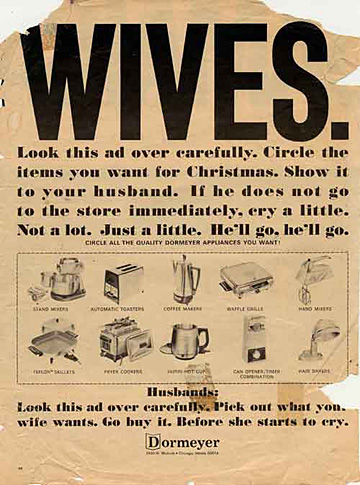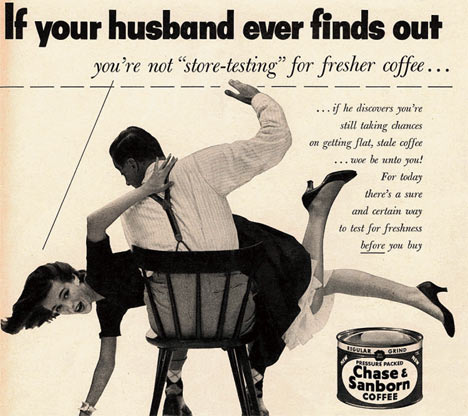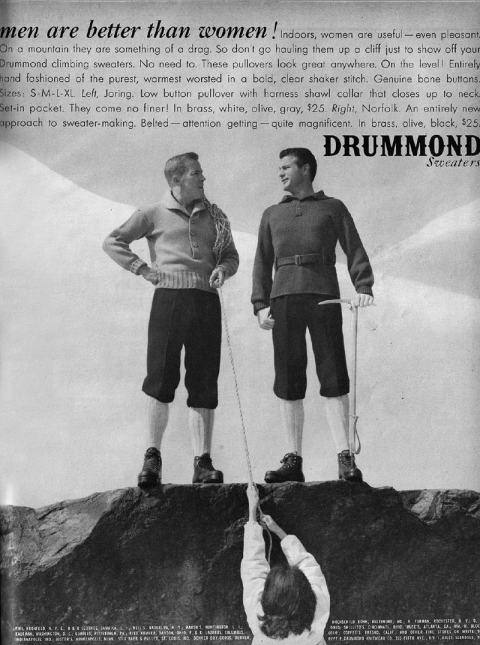-
Recent Posts
Recent Comments
- y8 happy wheels on 1950s Ads/commercials aimed at Women
- gorzow nieruchomosci on 19th century Household Technology
- When it comes to personal loans USA | 7N4ctwqy on Pros vs Cons of Gay Marriage
- idaho virtual office on Experience of Surrogacy
- Gansu, said construction lax control caused the day of a highspeed 31 kilo | www.louboutinpascher1221magasin.frkalF on Surrogacy in India
Frequent Topics
- 20th century
- 1950s
- Adolescents
- american dream
- anonymous
- birth
- census 2011
- childhood obesity
- children
- children under 2
- chores
- Christian fundamentalist
- commercial
- consumerism
- eugenics
- Family
- female targets
- Foucault
- gay
- Gay Marriage
- guest workers
- home economics
- homosexuality
- Homosexual Warning
- household roles
- Immigrants Hope Their 'American Dream' Isn't Fading
- kitchen
- majority not white
- marketing
- Media & Advertising
- minorities
- motherhood
- New York Times
- privacy
- Pros vs Cons of Gay Marriage
- school
- segmented marketing
- Slavery
- Social Media
- social network
- surrogacy
- television
- us population
- women
Archives
Categories
Meta
Monthly Archives: July 2011
“Maafa 21 The History of Eugenics In America Part 2 of 13”
Maafa 21 The History of Eugenics In America Part 2 of 13
This video is about Eugenics in America. After slavery was abolished the White race panicked and feared that the Black population would out number them. They decided to limit the black population by controlling how many children they could have, creating birth control and steralizing many of them.
The film is part 2 of 13 and it goes it depth on how the system worked. American Eugenicists tried their hardest to get rid of the Black population. This is a shameful part of American history, the land of the “free.”
Beauty over Comfort
Choosing beauty over comfort is something I’m sure we’re all guilty of. As we discussed in class, many individuals of the upper class purchase couches that are expensive and yet pretty uncomfortable. We can discuss why people of high culture spend so much money on uncomfortable couches and the only answer we can ultimately come up with is because it’s pretty and they would rather have an uncomfortable couch that was expensive instead of a decent looking couch at reasonable decent price all because their furniture is not actually meant to be used but to show off and look at.
The same rules apply for women who try to look nice for their husbands and for everyone in general when they step out the door. Tim Gunn, American fashion consultant and cohost of Project Runway, explains this idea perfectly in his article. He begins with saying that yes and “oversized t-shirts feel soft on your body, but you know what’s genuinely comfortable? Being dressed appropriatekly for your surroundings.” As a society, the women back then were focused on choosing the white or yellow frige, now we’re all worrying about what to wear and where and impressing passerbys all day. The idea he uses to back up his argument is that ‘when we look, we feel good.’
He even mentioned how he read an articel abnout a woman who even after being married to her husband for years, she made it her responsibility to get ready and make herself beautiful before he came home. He prasied the idea, I for one thought it was a bit much.
Is this what not just women with their fridges or their husbands, but society as a whole is oming down to?!
Posted in Assignment 2
Comments Off on Beauty over Comfort
1950s Ads/commercials aimed at Women
In the 1950s women were the primary consumers; the ones who made decisions on what was needed at home. Therefore I was curious on how did the market researchers of the 1950s and 1960s market products to women. The first one is a commercial for a refrigerator from the 1950s made by the company Kelvinator Refrigerator. It reminded me of the “more is better” state of mind during this period. For everyone who sees it, please note the amount of food in that refrigerator (LOL). It made me wonder how many people lived in this home during this time.
Apart from finding the conventional cheerful ads from these times, I did encounter some that were not so jolly but quite sexist. Coming from a post-feminist perspective I thought they were quite hilarious. But I think it is interesting that albeit the sexist remarks projected by the ads, these women still bought the products marketed to them. Even if it continued to reaffirm the stereotypes of women during these decades. Most of the advertisement I came by during this period were either made for white women/wives/mothers and white families. But looking ahead in the late 1960s, I did see the transition into market segmentation. More ads were aimed at African Americans than before. What follows were ads marketing to women in the 1950s:






I particularly enjoy the last one because during these time researchers were also understanding that women were not the only ones they should market to; but men also.
Consumerism and Pop Culture
Pop culture is a very dynamic entity, it decides what’s cool, what’s lame and has the ability to tell people what to buy therefore can be the deciding factor in the financial decisions multi billionaires make. It’s also something that will inevitably change over and over again throughout time. I always wonder who is it really that controls pop culture, because it isn’t something tangible, we can’t hold it in our hands or ask it what the next cool thing is going to be. Pop culture is simply formed of ideas that are shared and filtered through word of mouth and whatever means of communication exist in that period of time whether it be the telephone, written mail, magazines, newspapers, e-mails, etc. Then those ideas get filtered again and picked up by the consumers, whichever idea becomes the most popular will have the most invested, time, interest, and money therefore becoming “cool.”
What was cool in the 50’s and 60’s may not be cool these days, marketing strategies were different, morals were different, ideals were different, and the climate of pop culture was different. It’s amazing to see that there were such blatantly bias/racist advertisements in the past decades of the United States until someone presented the idea that let’s get the most money out of EVERYONE possible no matter what race, or social class, let’s just make some money. I don’t mean to sound like an old man after all I’m only in my early 20’s but back when I was a kid the main consumer demographic was at the age of 18-30 years old. Nowadays it seems like with this new tween wave of consumerism the main demographic is ages 9-12, which is considerably smaller and since when did children have such influence over the financial industry anyway because let’s face it, what’s “cool” is what is going to be making money anyway. I don’t know where this came from and I’m not a big fan of it, but I don’t wish it gone from existence I just would like a reason to all this successful tween consumerism being thrown in my face every time I turn on the television. Again I’ll just chalk it up to the ever changing entity of pop culture and what was cool and okay to do back then is different now. I posted a YouTube video of an old Jell-O commercial that seems questionable if it were on the air today but again this is pop culture in the 1960’s for you guys. It can be considered a stereotypical and offensive commercial to people so I’m just putting that out there for anyone who clicks the YouTube video.
Take Care,
Ryhan Ahmad
Posted in Assignment 2
Tagged commercial, consumerism, cool, financial, pop culture, television, tween
3 Comments
A New Use for PGD by Molly Mallin
I have out from this class what PGD is and what it is used for. In this article, they present a unique reason for using it. In this news article: Embryo genetic screening controversial- and successful from USA Today, Molly Nash’s parents turned to using PGD (preimplantation genetic diagnosis) to pick out an embryo implanted to give birth to her brother Adam, in an attempt to save Molly’s life.
The procedure with PGD involved the cord blood cells of Adam which were transplanted into Molly. Adam was picked for this because his immune system characteristics made him the perfect transplant candidate for his sister.
This definitley can give rise to some controversy on the side of the professionals regarding PGD. In the USA Today article, it says that Leon Kass, a former bioethics council chief of the American Enterprise Institute, brought up the issue of these newborns feeling unloved because of undergoing this procedure.
Other professionals worried PGD would be used on a widespread level for sex selection procedures at fertility clinics. This was stated in the article about the 2002 President’s Council on Bioethics. They were concerned about this issue.
In my opinion, this is actually a terrific procedure, (PGD and the transplant) which I think the professionals are over-reacting to. Molly Nash’s parents are not using PGD to create a designer baby. Nor are they being selfish in this situation. Their daughter, Molly was dying and she prevailed because of this great procedure. This procedure didn’t harm Adam either.
In the article we read for class: Born and Made by Sarah Franklin and Celia Roberts it says, on page 10, “At one level PGD is a technique, but it is also a choice, an experience, a threshold, a clinical specialism, a scientific achievement, and as we shall see, a place from which a particular kind of uncertainty and ambivalence is generated alongside confidence in its refinement, expansion and success”. This is true in this case, especially, with the Nash’s because success was achieved with the use of PGD and the transplant. In this way using PGD for the right reasons is necessary and in my opinion the transplant was truly a miracle.
Posted in Assignment 2
Comments Off on A New Use for PGD by Molly Mallin
Factors and Influence of Consumer Purchaseing
In the article Factors That Influence Consumer Purchasing by Steve Jonathan, showed that each individual different types of factors play role in consumer’s life while purchasing a product. The reason I choose that article because the article gives a relevant idea that we studied in the class that different classes’ consumers has a different type of taste and goal to purchase a product. For example: according to article,” Various factors influence purchasing habits including personal, social, psychological and cultural factors”. Consumer’s buying behavior is influence by their interest, status, and attitude. As a Social Factor, people always make a certain type of buying selection based on their position and status. On the other hand, Psychological factor influence consumer’s behavior through their beliefs and attitude. Motivation help consumer to find the satisfaction of their buying goods and services and Perception helps to make the decision to buy the product. At last, cultural factor make a big influence based on consumers basic values, ideals, and behaviors. Cultural influences vary to one to another, such as subculture and social class. According to subculture people share their values system and that subculture form of social cultural spread their interest and habits while purchasing a product.
The Role of Social Class in Segmenting Markets
This article in CiteMan talks about social class is closely associated with people’s buying behaviors. According to the author, social class segmentation involves two basic issues. The fundamental one is which approach better explains consumer behavior by using social class and income in segmenting markets. He suggests that many lifestyle items show the significant correlations with the index of social class. Moreover, social class is the better predictor of consumers’ living patterns in compare to income. He claims that income is often irrelevant in analyzing markets and explaining consumers’ shopping habits, store preference, and media usage. In fact, he describes that the radical differences in the spending patterns of three families belonging to different social classes with the same among earning per year. An upper middle-class family likes to buy houses in a prestige neighborhood, expensive furniture, and clothing from quality stores. A middle-class family has a better house but not in a fancy neighborhood and buy furniture that is not done by name designers. A working class family has a small house, but has a larger newer car, more expensive kitchen appliances. This family usually spends less on clothing and furniture.
This article is relevant to our class because it also illustrates the social class makes impact people’s buying behavior. In our class, we talk about that the working class often retain their distinctive class values, lifestyles, and tastes even though they have the same buying power as the middle-class. The working-class women think their primary role as house workers, while middle-class women define themselves as wives. For example, the working-class women buy a lot of top-of -the- line appliances because they contribute a more cheerful kitchen environment and make their work easier. They pay more attention to the useful function of applicances. In contrast, the middle-class women want the latest appliances to make their escape from the kitchen easily. They are more concern about the designs of applicances.
Posted in Assignment 2
1 Comment
Modern kitchen of late 1950s
I found this marvelous video archive of TV commercials of 1950s glorifying modern kitchen. I would say that it is extension of the ideas expressed in Nickles Shelley article and the way marketing strategies evolved throughout 50s.
The first commercial I find specially significant because it sells to both working class and middle class families. First it shows working class family and the way how they can make their kitchen more modern, by buying new appliances one at the time. Ad-makers in a way show working families that they can afford their products. They also prove to families that up to date kitchen saves a lot of time and turn chore of cooking into pleasure, thus appealing to a working class housewife who perceives her chores as work. I especially admired how ad was describing old refrigerator as “too small for present day supermarket shopping habits”, so family had to buy new bigger one to fit more goods in it. Ad also showed some details, like flower-printed curtains, that working class people could relate to, which was probably based on conclusion about working class taste drawn on researches described in article we read. It also showed families prospective purchases on their way to a new shiny modern kitchen, and named it “envy of the neighborhood”, reinforcing the connection between goods that family owns and their status among peers.
Next that commercial shows the kitchen of middle class family, that is already equipped with necessary appliances. To sell products to this family, ad makers emphasize the “look of tomorrow” that women allegedly want. They cater to middle class taste with charcoal grey appliances, using words ‘sophisticated” and “efficient”.
Clearly there is no limit to desire, families are pushed to buy newer, latest, better and in more quantities.
Posted in Assignment 2, Uncategorized
Tagged Family, kitchen, marketing, middle class, working class
4 Comments
Eugenics Today
After discussing the controversial issue of eugenics in class and going over how it was used for negative things such as forced sterilization and genocide I was curious if there was anything happening today in regards to it. I did a quick search and found this article about sterilization being used today in an organization called “Project Prevention” in California. This organization offers drug addicts the incentive of $300 if they agree to become sterilized. The goal of this is to prevent babies from being exposed to drugs while still in the womb and to prevent the pain and hardships of having to grow up with drug addicted parents. They use advertising campaigns featuring crying babies with the slogan “Get birth control or get sterilized and we’ll pay you $300!” This project has faced a plethora of backlash for several reasons. First, many feel this is a violation of civil rights by promoting a “vicious image of the external drug addict” with no focus on the internal human being. Secondly, this organization is preying on a vulnerable and desperate population of drug addicts, who are going to be willing to do almost anything for $300. I wonder if anyone who has gotten sterilized now regrets the decision. Perhaps these drug addicts will be able to clean up their lives and in the future want children. While it’s not technically “forced” sterilization, this entire process is very reminiscent of the history of eugenics in the US and shows how this entire ideology still has support for population control.
Posted in Assignment 2
1 Comment
Donor Insemination, a Difficult Decision.
I wasn’t really familiar with the topic of DI until taking this course and reading Katrina Hargreaves article on it. I came across some interesting clips, and also found out there was a major Hollywood film starring, Mark Ruffalo and Julianne Moore about this topic that was released just last year (2010), here is a preview:Film Preview.
The film is about a lesbian couple who choose to use DI to have children, when the children get old enough they decide to get in touch with the man who donated the sperm, technically their biological father and inform him that they are his children. The more time the children want to spend with the man, the more jealous their “mothers” become. Of course in Hollywood you can always expect the happy ending, everyone will get along and they will become one happy family, but that is not how it always turns out in real life.
Whether to tell the child about their biological parents is a very difficult decision. A lot of factors have to be taken into account, the psychological ramifications of such information, the biological parents interests or lack their of in the child’s life, the possible strain that telling the child will put into your relationship with them, and things of that nature. So many things can go wrong, the list is endless, this is why some couples feel it is better to just leave the child in the dark and have them continue to think that you are his birth parents, to avoid any confusion and the avalanche of emotions that come along with dropping such heavy information on the child. Personally I feel they have a right to know, but every couple has a right to approach it whichever way they deem fit.


